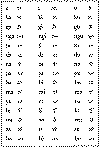Pre-Spanish
Filipinos knew how to write
By Ambeth Ocampo
DOCTRINA CRISTIANA is special to
the Filipinos not only because it is the
first book printed in the Philippines. It
also proves that, long before the
coming of the Spaniards in 1521,
Filipinos had their own language and
system of writing.
|

|
Early accounts of the Philippines by the Spanish missionaries
mention that Filipinos were a literate people with a written
literature. But pre-colonial writing was on material like leaves
and wood or even fragile rice paper and did not survive the
march of time.
Fortunately, the Doctrina is extant and reminds the Filipino at
the threshold of a new millennium of his vanished, pre-colonial
culture and civilization that antedates Magellan's tragic visit to
our shores in 1521.
Even Doctrina has only one copy left, and it does not belong to
the Filipinos. The only extant copy in the entire universe is not
in the National Library of the Philippines but in the Library of
Congress in Washington, DC.
Lost book found
The story of the discovery of the last Doctrina on earth is an
intriguing story by itself.
Although bibliographers have been citing the Doctrina from
1785, this unique copy turned up in Italy in 1942 or 1943.
Hardship in the war forced a school teacher to sell the book to
Luigi Banzi, a book dealer in Bologna. It was said to have come
from an unknown peasant family whose ancestors had visited
the Philippines in the early years of the Spanish colonization.
From Bologna the book changed hands and surfaced again in
the spring of 1946 in the collection of a Paris bibliophile, who
specialized in Pacific imprints. After some hard bargaining the
Doctrina was acquired by the New York book dealer William
Schab who sold it to the Philadelphia millionaire Lessing J.
Rosenwald.
Donated
In 1947 the book was donated to the US Library of Congress
where it now forms part of the Lessing J. Rosenwald collection.
Since then a number of offset reprints of the Doctrina have been
published making copies readily now available in the
Philippines.
Before the Doctrina turned up in Italy in 1942, we read a
reference to it in a letter Spanish Governor General Gomez Perez
Dasmariņas wrote to Philip II on June 20, 1593 reporting that:
''I have for this once, because of the existing great need, granted
a license for the printing of Doctrinas Cristianas, herewith
enclosed--one in the Tagalog language, which is the native and
best of these islands, and the other in Chinese--from which I
hope great benefits will result in the conversion and instruction
of the peoples of both nations; and because the lands of the
Indies are on a larger scale in everything and things more
expensive, I have set the price of them at four reales apiece, until
Your Majesty is pleased to decree in full what is to be done.''
Spain doesn't have it
Some scholars are of the opinion that the Doctrina in the Library
of Congress could be the very same copy sent to Philip II as no
other copy is extant in Spain.
This Doctrina was printed using wood-blocks on thin rice paper.
It has 38 leaves or 74 pages and measures a little over 9 inches
by 7 inches. Printing is only on one side of the page and is
uneven suggesting that a conventional press was not used.
Another explanation for the uneven printing is that the paper
used was so fragile that to press too hard on the wood block
during printing might have torn the page.
Doctrina's full title translates to ''Christian doctrine in Spanish
and Tagalog, corrected by the Religious of different Orders.
Printed with license in the press of San Gabriel of the Order of
Saint Dominic in Manila in 1593'' [Doctrina Cristiana en lengua
espaņola y tagala, corregida por los Religiosos de las
Ordenes. Impresa con licencia, en S. Gabriel, de la orden de S.
Domingo. En Manila, 1593.]
As the title suggests the book contains the Our Father, Hail
Mary, the Creed, Ten Commandments, and other texts in
Spanish and Tagalog.
What makes the Doctrina special is that the Tagalog texts are
printed both in the Roman alphabet and the pre-colonial script
more popularly known as the 'alibata'.
Contrary to popular belief, some parts of pre-colonial Philippine
culture like writing were not destroyed by the Spanish
colonizers but actually preserved and documented in works like
the Doctrina.
Filipinos interested in their history and culture may feel that
with the original Doctrina outside of Philippine shores, they
have been robbed of a priceless legacy from the past. But they should
consider that a rare book such as the Doctrina would not have
survived in the Philippines where it would be constantly
threatened by humidity, cockroaches, floods, fire and other
natural calamities.
Had this one copy been in the pre-war National Library in
Manila, what nature could not destroy would have been finished
off by the fierce American bombardment during the Battle for
Manila in 1945.
September 24, 1999 from the Philippine Daily Inquirer Internet Edition
Back to Top
Back to Tagalog Main Page
|